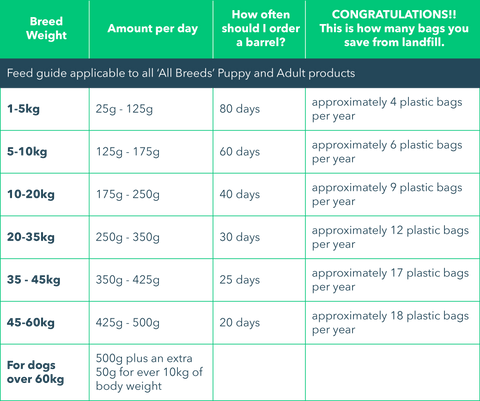Dog Feeding Guide Calculator Australia
The Ultimate Dog Feeding Guide Calculator for Australian Pet Owners
Keep your furry friend healthy and happy with the Australian Feeding Guide Calculator for dogs when using a premium grain free formula such as Man's Best Dog Food. Easily calculate your dog's nutritional needs with this helpful tool. Not only will you learn how much to feed your dog, with Delivery Hound, you will also see how much single-use plastic waste you will keep out of the environment too!
Feeding your dog the right amount of food is crucial for their health and wellbeing. But with so many different dog food brands and types available, it can be difficult to know how much to feed your furry friend. That's where our dog feeding guide calculator comes in - specifically designed for Australian pet owners, it takes the guesswork out of feeding your dog and ensures they get the right amount of nutrition they need.
Determine Your Dog's Daily Caloric Needs.
The first step in using our dog feeding guide calculator is to determine your dog's daily caloric needs. This will depend on a variety of factors, including their age, weight, activity level, and overall health. Our calculator takes all of these factors into account and provides you with a personalised recommendation for how many calories your dog should be consuming each day. From there, you can easily determine how much food to give them at each meal, based on the nutritional information provided on the dog food packaging.
Choose the Right Type of Dog Food.
Once you have determined your dog's daily caloric needs, it's important to choose the right type of food to meet those needs. There are many different types of dog food available, including dry kibble, wet food, and raw food diets. It's important to choose a high-quality dog food that is appropriate for your dog's age, breed, and activity level. Look for dog food that contains high-quality protein sources, such as chicken, beef, or fish, as well as healthy fats and carbohydrates. Avoid dog food that contains fillers, artificial preservatives, and other unhealthy ingredients.
Similar to us, our partners at Man's Best also believe that a high-quality grain-free formula is superior. Dogs, like humans, did not naturally consume grains as part of their evolutionary diet, making it challenging for them to digest. Their ancestry can be traced back to wolves, who thrived on a protein-rich diet consisting of horse, bison, and deer. While dogs have developed better grain-digesting abilities compared to wolves, many still face difficulties. Additionally, numerous dogs suffer from allergies to grains such as corn, wheat, and others, which frequently lead to skin problems and digestive issues. Check out the Delivery Hound Range of Grain free Dog Food Here.
Consider Your Dog's Age, Weight, and Activity Level.
When it comes to feeding your furry friend, it's important to consider their age, weight, and activity level. Puppies and senior dogs have different nutritional needs than adult dogs, and overweight dogs may require a different feeding plan than those who are at a healthy weight. Additionally, dogs who are highly active may require more calories than those who are more sedentary. Use our dog feeding guide calculator to determine the appropriate amount of food for your dog based on their individual needs.
Divide Meals into Smaller Portions.
One important tip for feeding your dog is to divide their meals into smaller portions throughout the day. This can help prevent overeating and reduce the risk of digestive issues. Depending on your dog's age, weight, and activity level, you may need to feed them multiple times a day. Use our dog feeding guide calculator to determine the appropriate portion sizes for each meal based on your dog's individual needs. Remember to also provide fresh water at all times and avoid feeding your dog table scraps or human food, which can be harmful to their health.
Monitor Your Dog's Weight and Adjust as Needed.
It's important to monitor your dog's weight and adjust their food intake as needed. If your dog is gaining weight, you may need to reduce their portion sizes or switch to a lower calorie dog food. On the other hand, if your dog is losing weight or appears to be hungry all the time, you may need to increase their food intake. Keep in mind that every dog is different and their nutritional needs may change over time, so it's important to regularly assess their weight and adjust their feeding accordingly.
How to Calculate Your Pet's Daily Calorie Requirement
The Dog Feeding Guide Calculator in Australia uses a formula to determine the Daily Energy Requirement (DER) of a dog, which is calculated by multiplying the dog's weight (x) by its Resting Energy Requirement (RER). This helps pet owners determine the appropriate amount of food to feed their dogs based on their individual needs and activity levels.
This calculation can help you determine how many calories your dog needs per day, which can then be used to determine how much food to give them. However, it's important to note that this is just a guide and other factors such as age, activity level, and health status should also be taken into consideration when determining your dog's feeding requirements.




